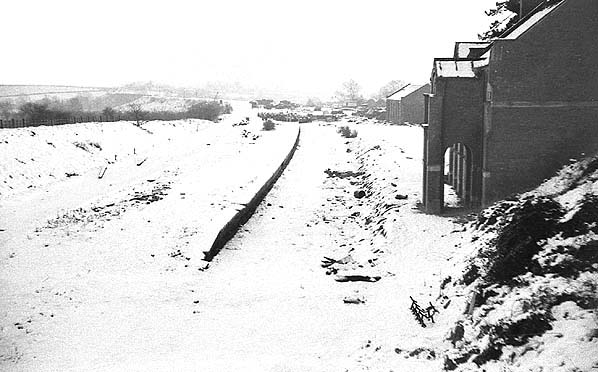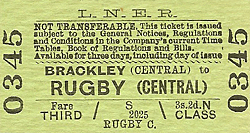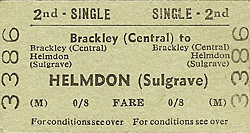
Station Name: BRACKLEY CENTRAL
|
| Date opened: | 15.3.1899 |
| Location: | Top Station Road runs through the site of the station |
| Company on opening: | Great Central Railway |
| Date closed to passengers: | 5.9.1966 |
| Date closed completely: | 5.9.1966 |
| Company on closing: | British Railways (London Midland Region) |
| Present state: | The platform has been demolished and the area redeveloped for housing. The roadside building was at a higher level this is still extant and in use as a tyre fitting workshop. The substantial goods shed has been restored and is now used as an office in an industrial estate. The stationmaster's house is in private occupation. |
| County: | Northamptonshire |
| OS Grid Ref: | SP591380 |
| Date of visit: | December 1968, July 1974 and 21.5.2008 |
Notes: Brackley Central was one of the larger intermediate stations on the Great Central, it still had an island platform but the platform buildings were more substantial with a canopy. The original plan was to have an entrance on the A43 road bridge, in line with other Great Central stations but following local concerns about traffic congestion a brick booking hall and offices were provided in a lay by off the A43 with a substantial covered footbridge spanning the down line to give access to the platform. Brackley was the only Great Central station built to this design. The goods yard was also on the down side of the line comprising five sidings, one serving a large goods shed which is passed through and another serving cattle pens. The goods yard also handled coal, wool, corn and timber, serving some of the industries of the town and surrounding area. Brackley was quite busy, especially during term time when pupils from outlying villages used the railway to commute to a number of large schools in the town including the Magdalen College School. The station survived until final closure of the line in 1966 and was missed by the town after closure with commuters having to travel to Banbury or Bletchley to catch a train. There were early proposals to make Brackley a junction with a branch from the town to Northampton and a third platform was partially constructed on the down side of the line with room for a third track through the station; the line was never built. BRIEF HISTORY OF THE GREAT CENTRAL RAILWAY BETWEEN SHEFFIELD AND LONDON In 1854, Edward Watkin became General Manager and then in 1864 chairman of the Company. Watkin's ambition was to build a rail link between the industrial heartland of Manchester and Sheffield, south to London and through a tunnel beneath the channel to reach Paris and the expanding markets of Continental Europe.
In the 1890's the MS&LR began construction of its 'Derbyshire Lines', in effect the first part of its push southwards. Leaving its east - west main line at Beighton Junction, some 5 1/2 miles east of Sheffield, the line headed south through the Nottingham coal field with a branch line serving its new Central Station in Chesterfield. In July 1890 the MS&LR obtained another act to extend from Chesterfield to Heath creating a loop line. Work started on this new section, of some 4¾ miles, before construction on the original line was finished and opened in July 1893 In 1893 the MS&LR obtained Parliamentary approval to extend this line to London (known as the ‘London Extension’. Construction of the 92 mile route started in 1895 and on 1st August 1897 the company changed its name to the Great Central Railway; it was the last 'main line' to be built until the Channel Tunnel rail link in 2003. Due to its late construction, the company was able to take advantage of the latest technology including steam excavators. It was heavily engineered with viaducts and wide cuttings with a maximum gradient of 1 in 128; there were no sharp curves or level crossings which would ensure a fast service for both passengers and freight. Most of the stations on the ‘London extension’ were built to a standard design consisting of an island platform with the booking office located on the platform. All the stations were built on an embankment or in a cutting adjacent to a road bridge, with access via stairs from the middle of the bridge; only the larger intermediate stations like Rugby and Loughborough had street level buildings. Because Edward Watkin also expected his trains to reach Europe through a channel tunnel, the line was also built to a larger continental (Berne) loading gauge. The Great Central opened for coal traffic on 25 July 1898, for passenger traffic to a new terminus at Marylebone on 15 March 1899 and for general goods traffic on 11 April 1899.
The new line was built from Annesley in Nottinghamshire to join the existing Metropolitan Railway which had now reached Quainton Road in Buckinghamshire, where the line became joint Met/GCR owned (after 1903), it returned to GCR metals near Finchley Road for the final section into Marylebone. In 1903, new rails were laid parallel to the Metropolitan Railway from Harrow to the junction north of Finchley Road, enabling more traffic to use Marylebone. Although the new line had now reached London, Edward Watkin was unable to fulfil his ambition as he was forced to retire through ill health. From the outset, the line had to compete with established north – south routes and the first train only carried a disappointing four passengers so the company had to work hard to win passengers from its rivals; with a well managed Advertising campaign and the introduction of a fast and efficient train service the companies fortunes slowly improved although it was never a match for its rival lines.In the 1923 grouping, the Great Central became part of the London & North Eastern Railway which brought an increase in freight traffic from the south Midlands and south west England but the LNER's main north - south route was into London Kings Cross so the Great Central was always considered as a secondary route.
In 1968 the London Railway Preservation Society chose Quainton Road as its new base, the society being renamed as the Quainton Railway Society; this has now developed into the Buckinghamshire Railway Centre covering 25 acres. The Centre boasts one of the largest private railway collections in the country with numerous steam locomotives, many housed in the former listed trainshed from Oxford Rewley Road which was dismantled and rebuilt at Quainton Road in 1999/2000. The shuttle service between Nottingham and Rugby lasted until 3rd May 1969. As closure approached a group of railway enthusiasts got together to discuss the possibility of buying a section of the track to operate preserved steam locomotives. A steam service was reinstated between Loughborough and Quorn in 1973 and in 1976 Charnwood Borough Council agreed to purchase the land from BR and lease it to the railway for 99 years. Despite a shaky start, the Great Central Railway PLC are now operating throughout the year between their headquarters at Loughborough Central and a new station called Leicester North just inside the city boundary. The remaining track between Leicester - Rugby was lifted in early 1970. North of Loughborough, the line remained open for freight traffic after closure to passengers in 1969 serving the gypsum mine at East Leake and the Ruddington Ordnance Storage and Disposal Depot south of Nottingham. This traffic ceased in the 1980's and the track north of Loughborough was mothballed by BR. In the early 1990's a group of transport enthusiasts set up the Great Central Railway (Nottingham) Ltd with the aim of redeveloping the derelict Ruddington Ordnance depot as part of a country park project. The depot was turned into the Nottingham Transport Heritage Centre (NTHC) and trains were run on a small length of line into the depot. The NTHC's aim was to reinstate the remaining line into Loughborough where it joins the GCR
Sheffield Victoria closed on 5th January 1970 with the closure of the Woodhead route and trains from Lincoln were diverted into Sheffield Midland. Although the southern section of the main line remained open, it too was proposed for partial closure in 1986. Aylesbury was to remain open but all services would run into Paddington via Princes Risborough. Marylebone Station was due to close on 12th May 1986 but the station was eventually reprieved and the closure proposals were rescinded. Following rail privatisation in the 1990's, Chiltern Railways took over the route and in 2006 two new platforms were built at Marylebone on the site of the old daytime carriage sidings. The new platforms and partial resignalling of the station throat now make it possible to run 20 trains per hour in and out of the station. North of Aylesbury the track remains in place but is only used by waste freight trains to the landfill site at Calvert where a junction with the Oxford - Cambridge line remains in use. On selected days, usually bank holidays, special passenger services run to the Buckinghamshire Railway Centre at Quainton Road station. There are now proposals to extend the passenger services northwards to a new station called Aylesbury Vale Parkway at the point where the line crosses the A41 near Berryfields Farm. This area is to be known as the Berryfields Major Development Area and will include park and ride facilities for Aylesbury.With our motorway network now working at capacity there have been a number of proposals to reopen other sections of the Great Central main line and in 2006 Central Railway was formed to look into the feasibility of building a new rail link from central England to the Channel Tunnel which would include rebuilding part of the Great Central route south of Rugby reviving a 1990’s government proposal to reopen that section of the line as part of a fast rail link from Scotland to the Channel Tunnel. Preservation group web sites: The Buckinghamshire Railway Centre, The Great Central Railway (steam service between Loughborough and Leicester North) & Nottingham Transport Heritage Centre (steam service between Ruddington and Loughborough) Selected other web sites: The Transport Archive contains further detailed history of the Great Central plus a vast collection of 2344 'on line' photographs many ( the Newton Collection) taken during the construction of the London Extension. Chris Ward's Annesley Web site featuring numerous photographs of the Great Central around Nottingham and the Annesley Motive Power Depot. Great Central Railway through Leicester. Nigel Tout's web site with numerous photographs of the Great Central remains around Leicester and a series of archive photographs of the line. Bridging the Gap details ongoing work to reinstate the link between the two preserved lines. The Great Central Railway Society promotes an historical interest in the Great Central Railway. Selected further reading: Great Central Memories by John MC Healey published 1987 by Baton Transport ISBN 0 85936 193 4 - heavily illustrated history of the London Extension. Great Central Then and Now by Mac Hawkins - published (2nd edition) by BCA 1992 ISBN 0 7153 9326 X , station by station photographic survey of the Great Central between Sheffield and London with numerous 'then and now' photographs. See also Sheepbridge & Brimington Station and construction of the Manchester, Sheffield and Lincolnshire Railway through Brimington by Philip Cousins. Published in St. Michael & All Saints, Brimington parish magazine. (Click here for full text). All tickets from Michael Stewart. Too see other stations on the Great Central Railway between Sheffield Victoria and Aylesbury click on the station name: Aylesbury, Waddesdon, Quainton Road (1st site), Quainton Road (2nd site)**, Calvert, Finmere, Helmdon, Culworth, Woodford Halse, Charwelton, Braunston & Willoughby, Rugby Central, Lutterworth, Ashby Magna, Whetstone, Leicester Central, Leicester North***, Belgrave & Birstall, Rothley**, Swithland****, Quorn & Woodhouse**, Loughborough Central**, East Leake, Rushcliffe Halt**, Ruddington, Ruddington Factory Halt, Arkwright Street, Nottingham Victoria, Carrington, New Basford, Bulwell Common, Bulwell Hall Halt, Hucknall Central, Annesley South Junction Halt, Hollinwell & Annesley, Kirkby Bentinck, Tibshelf Town, Pilsley, Heath, Staveley Central, Renishaw Central, Killamarsh Central, Beighton (1st site), Beighton (2nd site), Woodhouse Junction, Woodhouse*, Darnall*, Sheffield Victoria & Sheffield Bridgehouses. |
old1.jpg)
Photo by S W A Newton from Leicester & Rutland Record Office

1954 OS map, Brackley Town Station is seen to the south. Brackley Town was first
to close on 2nd January 1961
old5.jpg)
old6.jpg)
Photo by Ben Brooksbank
old9.jpg)
Photo by J E Connor

Photo by Nick Catford

Photo by Nick Catford

|




 Home Page
Home Page